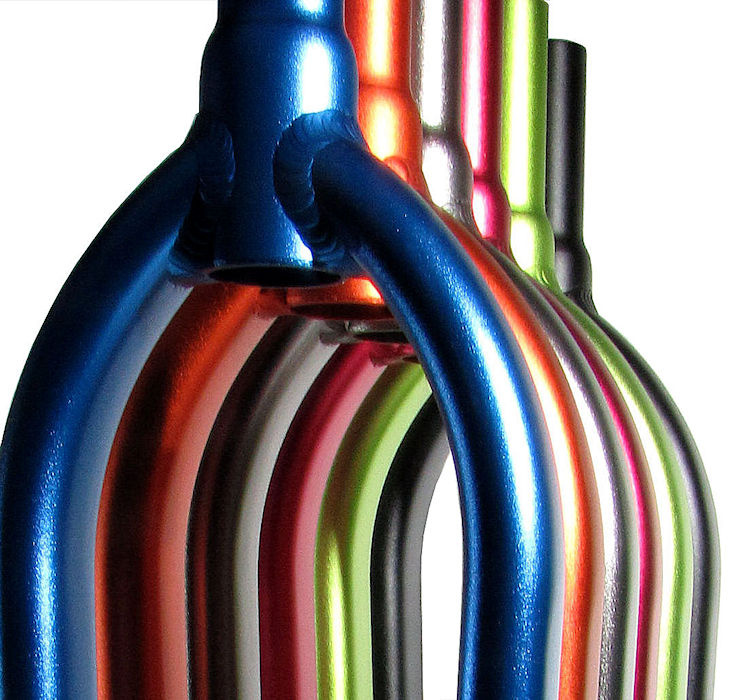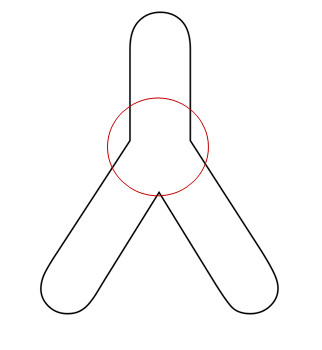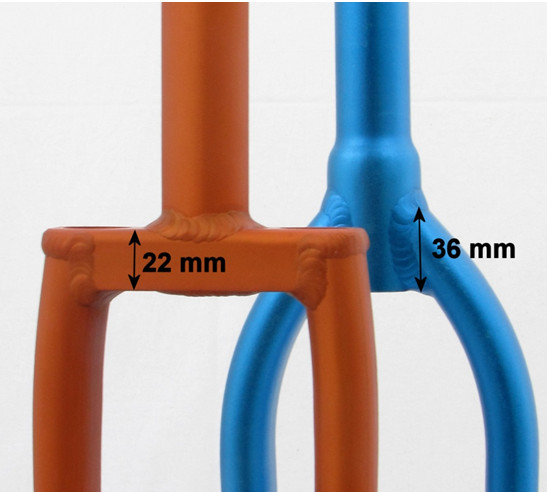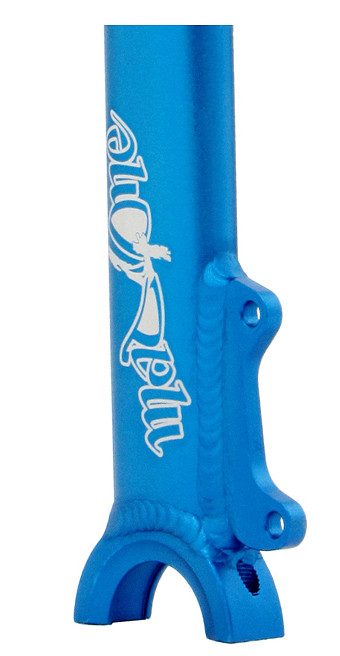Better material means longer life,
as well as more stiffness and better performance.
A unicycle may be designed in many ways,
but only a few of them are the right ones.

The SHAPE
The frames can we divided into two families:
- SQUARE frames, designed to perform tricks that involve the riders foot to be placed on the crown (Freestyle, Flatland, One Foot Race),
- ROUND frames, designed to protect riders knees (mountain unicycling, trial, road), when your riding style does not require your foot on the frame crown.
- COMBINED” use also exists, especially in the 19”- 20” wheel sizes, where a square frame is often used in specialties that do not require it.
The STIFFNESS
The first thing to consider is the STIFFNESS.
This should enable the object to be used without bending. The required stiffness is determined by the use of the object (in this case the frame), as well as by the weight and strength of the rider.
Unfortunately we have often seen unicycles stiff enough for a 50 kg girl, which however break within a few minutes if loaned to a stronger and heavier rider:
That is STIFFNESS?
Stiffness is the extent to which the element is able to resist deformation, deflection or breakage under the action of an applied force.
The RIGIDITY
The next important feature is the RIGIDITY of the structure. The rigidity is determined by:
- MATERIAL, i.e. it depends on the quantity of material as well as the material itself.
- SHAPE: the tube section shape determines the final stiffness and rigidity of the element. As the diameter increases, for the same weight, the thickness decreases and stiffness and rigidity increase (we cannot reduce the thickness too much, because the unicycle is often subjected to unexpected shocks).
- FASTENINGS: where and how a frame is connected affects rigidity. As an example: a rod anchored to the two ends has a greater rigidity than a rod anchored at one end only.
The stiffer the frame, the faster and more precise its response will be to our impulses/commands.
Like a scalpel, the frame must first of all be precise.
A blade that bends or vibrates makes the surgeon's job difficult or rather impossible.
The same goes for our unicyclist: as he becomes more and more skilled he will be required to perform certain tricks with the precision of a surgeon.
In Freestyle, Trial, but also in Mountain Unicycling, a "soft" or "flexible" frame will be increasingly ineffective or even dangerous.
What is RIGIDITY?
Rigidity is a measure of elasticity, and represents a material’s resistance to permanent deformation.
We are also referring to structural rigidity, which is the property of a structure that it does not bend or flex under an applied force. The opposite of rigidity is flexibility.
The DURABILITY
The last two aspects to be considered however are the WEIGHT and the DURABILITY of our unicycle, which are the result of all decisions made by the designer.
After having defined SHAPE – STIFFNESS and RIGIDITY, the designer then determines the required details, i.e. MATERIALS, DIMENSIONS and FASTENINGS, which are required to create that frame.
What is DURABILITY'?
Structural Durability deals with the capability of structures or components to withstand the loads encountered in service over a specified period of use without failure occurring in the form of incipient cracks or unacceptable degradation. Durability can be measured in different ways, depending on the field of application. For example in years of life, hours of use or operating cycles.
For the same weight, aluminum is more rigid and expensive while steel is cheaper and more flexible.
... and now two words on ALUMINUM
Aluminum is a chemical element with the symbol Al.
It is by far the youngest among industrial metals, having been produced for the first time on a large industrial scale just over 100 years ago.
Aluminum is almost always alloyed (alloys in which aluminum is the predominant metal), which markedly improves its mechanical properties, especially when tempered.
Its main characteristics are:
- light (has a specific gravity of about one third of steel),
- impact resistant,
- durable,
- excellent corrosion resistance;
- 100% recyclable.
... a few words on STEEL
Strictly speaking every steel is an alloy, but not all steels are called "alloy steels".
The simplest steels are iron alloyed with carbon. However, the term "alloy steel" is the standard term referring to steels with other alloying elements added deliberately in addition to the carbon such as e.g.
- silicon, that increases strength but reduces weldability;
- copper, for higher corrosion resistance;
- manganese, that increases hardness but decreases elasticity;
- chrome *, that increases hardness and does not reduce elasticity.
The composition of the alloy also determines the grade of steel. In fact, we have common carbon steels (used in applications that do not have particular needs) and special steels (which give the alloy particular properties).
** The Mad4One steel frames, we are talking about the URC family by Mad4One, are made with Cr-Mo 4130 chromium-molybdenum steel, an alloy of steel that guarantees greater load resistance, lower specific weight and better tensile strength compared to unalloyed steel..
Therefore it is not sufficient to speak only of aluminum and steel, because there are innumerable aluminum and steel alloys with very different characteristics. The choice of the "right" material is a very important element of the entire frame design.
The FATIGUE
Another feature often ignored is the concept of FATIGUE OF THE MATERIAL.
FATIGUE is the weakening of a material caused by cyclic loading that results in progressive and localized structural damage and the growth of cracks. Once a fatigue crack has initiated, each loading cycle will grow the crack a small amount, typically producing striations on some parts of the fracture surface. The crack will continue to grow until it reaches a critical size, which occurs when the stress intensity factor of the crack exceeds the fracture toughness of the material, producing rapid propagation and typically complete fracture of the structure.
Each materials has two values which define it:
- The Yield Strength, is the stress corresponding to the yield point at which the material begins to deform plastically. The yield strength is often used to determine the maximum allowable load in a mechanical component, since it represents the upper limit to forces that can be applied without producing permanent deformation;
- The Ultimate Tensile Strength, or Tensile strength is the maximum stress that a material can withstand before breaking. The ultimate tensile strength is higher than the yield point.
The fatigue damage process of a material can be divided into the following steps:
- The opening of a fracture: this first stage, also called micro structural adjustment of the plastic component of the material, stabilizes some mechanical and physical characteristics of the same,
- In the following phase the micro-intrusions and micro-extrusions give start to the damage by fatigue. In fact at the bottom of the micro-intrusions the stress is amplified and grows until a macroscopic crack is formed,
- The microscopic crack grows: the crack propagates for a small distance along the direction of the extrusion defects, then it grows in an orthogonal direction to the external direction,
- Final fracture: the crack reaches the critical length and this leads to a progressive decrease in resistance. The cracked component breaks because it can no longer sustain the peak load.
However, if we apply a force slightly lower than the yield point, the material keeps its shape, but micro-fractures are produced inside.
If we keep on using the structure, these micro-fractures will lead to the breaking of the material without having ever exceeded ever the yield strength nor the yield point.
In other words this is the concept of FATIGUE, which we often see with steel spokes and with other aluminum parts.
Many unicyclists have had this experience: “…I did the same things as usual, and today it broke. I didn't do anything excessive, how could it happen? ... ".
Principally, this tells us that all materials, due to FATIGUE, are time-limited. This depends on the quality of the material and on all the elements of the design.
For this reason, the choice of the material resp. alloy to be used is a fundamental step for the final result of our project.
Aluminum is stiffer but less strong than steel and therefore is more subject to FATIGUE.
But let's go back to our frame

The design of an unicycle frame is basically an inverted "Y".
The most stressed point of the frame is the center where the three legs are connected to each other (right leg-vertical tube-left leg).
Here the FASTENINGS enter the scene (which are one of the three elements that determine the structural RIGIDITY of the frame).
In the unicycle the right and the left leg are connected together at the bottom through the hub and at the crown, whether square or curved, to the vertical tube. This emphasizes how important the connection with the vertical tube is.
Let’s imagine we have to plant our beach umbrella:
the stability of our beach umbrella largely depends on the depth of the hole in which we will place it (we will call it "interlocking depth").
Even if we use a rigid base the depth of the hole is still important. If the base is not sufficiently deep, the interlock will be instable or weak.
Let's go back to the connection point between the vertical tube and the right/left leg of the frame:
As for our beach umbrella, the interlocking depth between vertical tube and base is very important.
The SQUARE-shaped MAD4ONE aluminum frames

THE THICKNESSES
have an interlocking depth of 22mm. This size has been defined in the design-phase, taking into consideration also how this part is going to be used.
The lower the interlocking depth, the shorter the distance between foot and tire.
The greater the interlocking depth, the stiffer the entire part will be.
This size is therefore the result of a compromise between functionality and stiffness, being aware of the fact, that lower thicknesses will compromise the stiffness of the entire frame.
The vertical tube of the MAD4ONE frame is made out of a single piece and has variable thicknesses. Where the vertical tube interlocks and for the first 8 cm, the tube wall is 6mm thick.
Through experience, we learned that decreasing the interlocking depth exerted strains at that point become so great that compromise the durability and often also the stiffness of the part. I.e., with lower thicknesses we shorten the life of the frame greatly, and risk sudden breakages.
The interlocking depth alone is not sufficient to guarantee stiffness and durability.
Thickness and quality of the material in this spot of the frame are important for the final result, too.
The MATERIAL
The SQUARE-shaped MAD4ONE frames are made of aluminum alloy AL6069-T6, which differs from the common AL6061-T6 in the following aspects:
- Superior resistance to deformation up to +30%
- Greater load resistance
- Greater load resistance in presence of corrosion
THE THICKNESSES
For those who are interested in this topic here the link to the academic study “Strengthening in the new aluminum alloy AA 6069” of S.C. Bergsma a, M.E. Kassner b,*, X. Li, M.A. Wall. Here they describe the properties of this new aluminum alloy.
Link:
https://www.cambridge.org/core/journals/journal-of-materials-research/article/abs/effect-of-fe-on-microstructures-and-mechanical-properties-of-an-almgsicucrzr-alloy-prepared-by-low-frequency-electromagnetic-casting/D97D7E84D9847CA68325CD3A2629FD53#
The ROUND-shaped MAD4ONE aluminum frames

THE THICKNESSES
They do not have the same interlocking restrictions as the square ones. For this reason, we could achieve in our frames a higher interlocking depth, i.e. 36mm.
This size significantly reduces the load applied in that interlocking region ensuring very high rigidity and durability.
The MATERIAL
The ROUND-shaped MAD4ONE frames are made of aluminum alloy AL7005-T6, that compared to the more common AL6061-T6 has a greater load resistance (+ 12%) and a higher fatigue resistance (+56%).
Furthermore, we pay also great attention to the diameter-thickness ratio of the tubes.
Similar to the SQUARE-shaped frame, the vertical tube of our round-shaped frames is of variable thickness. In the interlocking area a tube diameter of 40mm and a tube wall thickness of 3.6mm gives greater rigidity and strength to the entire structure.
The aluminum alloy AL7005 has an Ultimate Tensile Strength of 350MPa, a Fatigue Strength of 150MPa and a density of 2.78g/cm³ compared to a Ultimate Tensile Strength of 310MPa and Fatigue Strength of 96.5 MPa and a density of 2.70g/cm³ for 6061 aluminum alloy.
For those who are interested in this topic here is the link:
https://en.wikipedia.org/wiki/7005_aluminium_alloy#Specific_forms_of_AL_7005_include

The sizing of legs and disc brake mounting tab as well as the quality of material and welds are the features that characterize the MAD4ONE frames.
In the world of the Mountain Unicycle (Muni) another area of the frame which is particularly stressed (in addition to the interlocking legs-vertical tube), is the spot where the disc brake is fastened to the frame.
In recent years the use of the Mountain unicycles has changed a lot, thanks to the advent of the disc brake.
In fact, we no longer must control our body balance (forwards and backwards) with the feet as we now use the brake for this purpose. This however means a more continuous use of the brake that necessitates a precise and timely response of the brake system.

The disc brake develops very high loads and often also high temperature in the area where it is fastened to the frame.
The combination of these two effects leads to faster weakening of the material (material fatigue), that initially causes vibrations, compromising the timely response of the brake (potentially dangerous for the rider), and subsequently leads to the braking of the frame or of the disc brake mounting tab.
We would like to conclude with a brief discussion on two high-end materials, that we think are not optimal for our Unicycle World, not only because of their high costs, but also for some of their properties.
CARBON
Carbon fiber consists of sheets of carbon fibers.
The mechanical properties of the fiber depend on the type of starting material, the type of interlacing of the fibre and on the subsequent processing. For the same weight, we may obtain very different resistance and torsion properties.
Carbon fibers have several advantages including: tensile strength, rigidity, resistance to fatigue, to aging and corrosion. However it also has weak points in addition to its high cost.
Carbon fiber is very strong when stretched or bent, but weak when compressed or exposed to high shock (e.g. a carbon fiber bar is extremely difficult to bend, but will crack easily if hit with a hammer).
Once a carbon structure is dented or cracked you cannot fix it like you can fix a steel structure. Structural damage results in broken fibres and structure is unlikely to retain its strength.
In most cases the structure has to be removed, thrown away and be replaced by a new one.
A couple of examples:
- An aluminum bike handlebar bends if you crash into a tree, a carbon handlebar may crack, but maintains a solidity and an apparent structural integrity. However, when we subject the carbon part to important stresses (e.g. landing from a jump), it may catastrophically break.
- If we tighten a carbon frame in a bike holder-clamp fixed to the car roof we may cause the fibers to break without them showing any apparent defect.
In both cases we speak of improper uses, stresses or even high impacts on the carbon structure for which it has not been designed and built.With carbon you can build very rigid or flexible tools, a classic example are fishing rods, however any fisherman will tell you how delicate they are...
TITANIUM
There are different types of titanium (grade 1,2,3, 4) and titanium alloys (grade 5 to 38).
As with other materials, its mechanical characteristics as well as its workability and weldability may vary widely depending on the type of titanium used.
The specific weight of titanium is halfway between aluminum and steel while the mechanical characteristics may vary greatly, however they will never exceed those of steel alloys.
If we consider the high cost of titanium, the relating manufacturing costs, as well as its weight-mechanical performance ratio, we believe that the right aluminum alloy together with the correct design can today offer similar characteristics at much lower costs.
Last but not least ...
FREEDOM matters!
In our case, if we talk about “Freedom” we mean “Compatibility”.
The unicycle consists of 3 sets of elements (saddle-frame-wheel).
In the design phase we pay great attention to comply with the standards that have established in unicycling over the years. That is all the parts we manufacture have a standard interface so that they can be combined without problems with other standard-parts available on the market.
Only the Mad4One RACE REVOLUTION, developed in 2011 (5 gold medals at the World Championship 2012 in Bressanone - UNICON XVI), and further improved in 2018 (8 gold medals with Niklas Wojtek and Alina Czimek at the World Championship 2018 in South Korea - UNICON XIX), has a specifically designed interface.
Why have we moved away in this case from the ISIS concept and therefore from a standard approach?
To increase the effectiveness of the force we apply when we push on the pedals, it was necessary to reduce the distance of the feet from the center. To achieve this, we developed a hub-crank interface that is less bulky than the ISIS one.
To conclude here is the
which we are particularly proud of.
It's the list of the best results achieved by riders who have attended the last World Champions riding a Mad4One unicycle.

